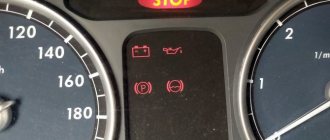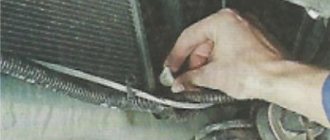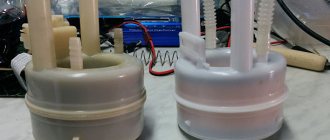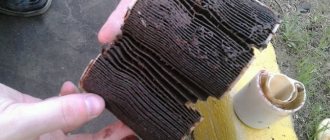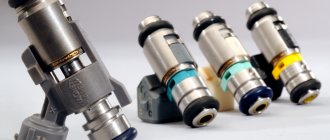Fuel filters for the VAZ 2113/2114/2115 will not differ from each other, since the car is a restyled version of the VAZ 2108, 2109 and 21099. Over the years, these cars were produced in different versions and modifications. Initially, the VAZ-2115 had VAZ-21093 (carburetor) and VAZ-2111 (injector) engines. By the time production of the VAZ-2114 began, carburetors were completely abandoned and all VAZ 2114 and 2113 cars were already produced with an injection type engine. Therefore, fuel filters will differ depending on whether the fuel system is carburetor or injection.
In injection cars VAZ 2113/2114/2115 there are two filters installed, the main one is a fine filter and an additional coarse filter, which is a synthetic fiber mesh filter, which is located in the tank along with the fuel pump.
What is a coarse filter
Modern products are superior in quality to their predecessors. The technology has been improved and errors have been taken into account. The diesel fuel coarse filter is an important element of the entire vehicle fuel system. Essentially, the device functions like a sump.
Essential elements:
- Metal carcass ;
- Cotton filter element;
- Housing with lid.
The elements are arranged in such a way that the filter is able to efficiently clean coarse impurities.
The thread that performs filtration is quite tightly connected to both the lid and the body. The end surfaces of the filter are very soft; the annular ribs of the housing and cover are pressed into them. Due to this, the desired density effect is achieved.
Paper and other filter elements
Paper serves as the main filter element. Despite the general technological process, it is the leader among all filter materials, having great advantages.
Paper is used for a reason; it is folded into a corrugated shape. The material is pressed very strongly, and an accordion with a diameter of 100 mm can accommodate a canvas measuring more than 1 meter.
Interestingly, paper costs account for more than 60 percent of the price of a fuel filter. In fact, you can make the design cheaper, but only at the expense of quality!
Propylene is the material of the future. It has been actively used recently. He has already earned a lot of praise from motorists.
Article on the topic: How exchange rate stability (dynamic stabilization) systems ESC, DSC and the like work
As for fine-pored metal mesh, it is rarely used as a material for filters.
Price
What is the optimal cost of the product? Here are the cheap, medium and expensive options:
— Filter for ZIL, MAZ, KAMAZ BIG for 130 rubles. Has a plastic body. The height is 201.5 millimeters, and the required diameter is 51/42 millimeters.
— URAL filter, KAMAZ assembly LAAZ for 1010 rubles. The height is 0.15 millimeters, it weighs 2.75 kilograms. The width of the product is 0.15 meters, and the length is 0.2 meters.
— KAMAZ PreLine420 filter assembly SM for 3350 rubles. The filter weighs 2.23 kilograms and its height is 0.12 meters. The length is 0.34 meters and the width is 0.14 meters.
Difference between coarse and fine filters
There are only two filters in the fuel system, because there are only two main stages of fuel purification. These devices are: coarse and fine filtration. They are similar in operating principle, and they also resemble each other in appearance. In many ways, the filters are similar in design. Initially, the fuel, of course, enters the coarse filter, and then into the fine filter. In this way, optimal liquid purification is achieved. It is also possible to use additional elements, for example, an additional coarse filter.
The devices differ in a number of parameters. Each has its own characteristic features. Rough cleaning is carried out from particles of 0.1 millimeters or more. Fine cleaning does not allow particles of 0.015 millimeters or larger to pass through. As a result, the desired filtering result is achieved.
These two filters differ not only in the size of the particles passed through. They also have a difference in location. For the fuel system to operate correctly, both devices must be in good working order and of high quality, so you should not skimp on these parts.
The picture above shows a fine cleaning device. Outwardly it looks quite similar to a device for coarse filtration, doesn’t it?
Purpose
A guarantee of the performance of any machine is forced cleaning of the fuel. Any engine running on liquid fuel requires a filter. As a rule, several cleaners are installed on modern cars.
Inside the filter, materials are used that block the passage of particles of dirt, dust and other solid inclusions that negatively affect the elements of the internal combustion engine.
Photo of the location of the filter in the tank
On diesel units, which are very sensitive to impurities, an additional separator is also used, which helps to clean the diesel fuel from water. The operation of such a filter is based on the principle of water gravity. As you know, diesel fuel is lighter than it, so the sensor float sinks in clean fuel, and if water is mixed, the buoy stands on the surface, thereby sending an impulse to the display.
Additional filters
An important thing because it cleans fuel, which contains a large amount of water. The package includes a strainer that is integrated into the low-pressure pump, other standard components, as well as a thirty-micron diesel filter with a water separator.
Such filtration is especially relevant in our country due to the unpredictability of fuel quality.
Replacement
Sooner or later, the coarse cleaning device will have to be replaced. The replacement process, of course, is provided for by technology: there is a hole in the roof, closed with a plug, which is designed to remove air during the replacement. A competent filter replacement can be done at a service center with a good reputation.
Coarse cleaning devices will remain relevant for a long time due to insufficient filtration of fuel before it enters the fuel system. However, even if one day the fuel is completely clean, careful people will still install filters and do the right thing. This will allow you to insure yourself in case of the presence of certain impurities. Situations are different, and, of course, it is better to provide for any, even unlikely, options.
Clean fuel and an easy road for you!
Replacing fuel filters in carburetor engines
To change the filter, buy a new filter from an auto store (based on the car make, model and year, and in some cases, carburetor type). Again, look for filters from reputable manufacturers that are sold at a discount. Check out 4 and buy modern worm gear clamps if yours look old, rusty, flimsy, or have spring or screw clamps. The filter and new clamps are usually inexpensive.
Here's how to change the fuel filter on a carburetor engine.
1.Unfasten the clamps holding the filter.
2.Remove the old filter and install the new one.
The filter usually has an arrow indicating the direction of fuel flow, but before removing the old filter, look and remember which way the arrow pointed.
3.Install the clamps.
If you clamp the clamps well and tightly (without squeezing the hose), then there will be no fuel leakage.
Replacing fuel filters for injection engines
Replacing fuel filters for injection engines is more difficult than replacing a filter in a carburetor car. First you need to turn off the fuel pump and relieve pressure in the gas line. The filter in the gas line can be secured with clamps, threaded fasteners, and quick-connect fasteners. If the fuel line has a threaded connection, you will need a special socket wrench for the fuel line. If the fuel line has quick-release fasteners, you will also need to buy a special tool to disconnect them. Ask your auto dealer or the parts department of the manufacturer's representative office for the type of filter you have. If this infrequent job requires the purchase of special tools, it may be significantly cheaper to enlist the help of a qualified mechanic. If not required, the following instructions will get the job done.
1.Before disconnecting, relieve pressure in the fuel line.
To do this, turn off the electric fuel pump before starting the engine. Do this.
With the ignition off, remove the fuel pump fuse from the fuse box (the instructions should indicate where it is located), following the instructions in Chapter 12, “Adjusting Electrical Equipment.”
Make sure that the parking brake is applied and the car is in neutral (for automatic transmissions, “Park” mode), and then start the engine. After starting, it will not work for long, the pressure in the gas line will drop and the engine will stall.
Turn off the ignition.
After this, you can disconnect the fuel line from the filter.
2.Before installing a new filter, look at it.
You should see a stamped arrow on it indicating the direction of fuel flow through the filter.
3.Install the new filter so that the arrow on it points towards the engine.
4.Replace the fuse.
5.Check whether the parking brake is engaged and whether the car is in neutral or “Park” mode, then start the engine and check for any leaks near the filter.
If it turns out that not enough fuel is supplied to the engine (or it is not supplied at all), then there may be several reasons: a clogged fuel line or filter, a malfunction of the fuel pump, fuel injector or carburetor. Before
If you let anyone talk you into changing the fuel pump, test it yourself to see if it is the cause of the problem. This can be easily done by disconnecting the hose that supplies fuel from the pump to the injectors or carburetor on the side farthest from the pump and placing it in a clean bike. Then, with the handbrake applied and the gear in neutral, have someone crank the engine while you watch for fuel coming out of the hose. If it does, then the fuel pump is doing its job and, most likely, the problem lies in the fuel line.
Turn off the engine before the fuel overfills the can, and be careful not to spill it - it is highly flammable.
If the pump needs to be replaced, it is not necessary to buy a new one. A remanufactured rMi pump may work just as well as a new one, but it will cost you much less. If you feel confident with your appliances, take advantage of the repair kits supplied by some manufacturers. You can easily disassemble the pump yourself using a screwdriver and repair it by following the instructions in the kit. If you are not enthusiastic about this idea, ask the car service center to find and install a reconditioned pump for you. It must have a warranty of at least three months.
If the engine idles rough, then... Before proceeding with other adjustments, you should check the PVK valve (5).
When the engine is running, a certain amount of fuel and exhaust gases break through the piston rings into the crankcase. Previously, these gases were simply released into the atmosphere through a special pipe, because their accumulation in the crankcase contaminates the oil. Since the early 1960s Basically, a method called forced crankcase ventilation (G1VK) was used. This is more effective and environmentally cleaner: instead of polluting the air with exhaust gases, they are sent to the intake manifold and again enter the cylinders along with the rest of the combustible mixture. PVC increases fuel economy as the engine is running both on exhaust gases and on the combustible mixture.
Not all cars, but many have a breather or PVC valve. If your car has one, check it every time you make an adjustment to make sure it isn't clogged with dirt from exhaust fumes. If it doesn't work.
then the balance of the combustible mixture created taking into account these gases will be disrupted, and the engine will not be able to operate efficiently. Most manufacturers advise changing PVK valves every 20 thousand km.


